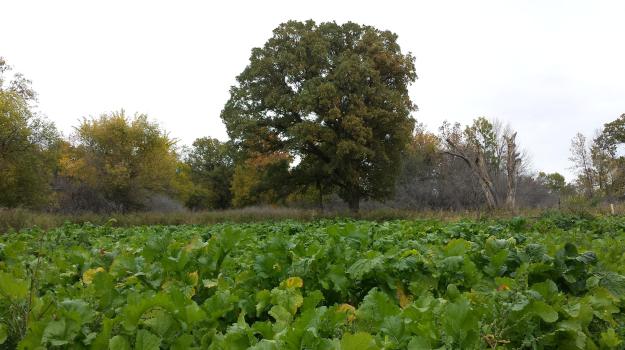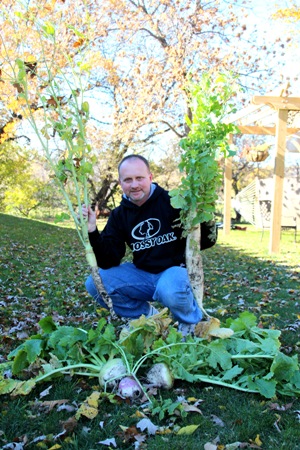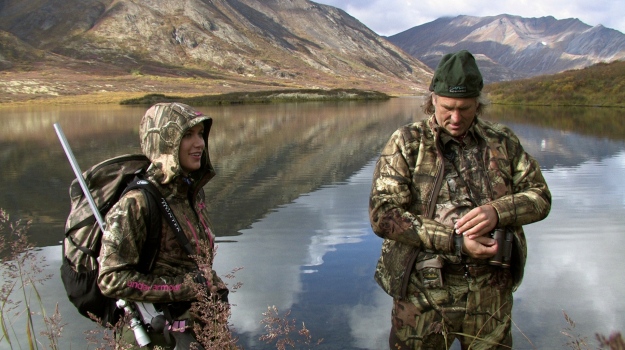D.J. Randolph | Mossy Oak ProStaff Regional Manager

I have been asked many times why I plant food plots when I live in North Dakota. “North Dakota is one giant food plot. The deer have everything they want and need!” The answer is,“That’s exactly why I plant food plots.”
Acreage
A lot of the area that I hunt is surrounded by peas, beans, sunflowers and corn. These are all wonderful food sources that deer love. But, the goal of a bowhunter is to get deer within their effective range, usually around 30 yards or so. If I have 200 acres of corn and 300 acres of sunflowers near my stand/blind that will keep deer in the area but it does not get them into my effective range. I have sat in many treestands overlooking crop and watched deer move all day but never having one come in close enough to shoot. In open flat areas there are often few desirable trees and/or no natural funnels to move the deer where you need them to be. Small, strategically placed food plots can get them to where you want them to be.
Variety
Few of us like to eat the exact same thing every day. Corn, beans, flowers, corn, beans, flowers, repeat, repeat. Animals are no different from us, occasionally they like something different. So when there are crop fields as far as the eye can see, I try to plant something out of the ordinary.
Where, What & When?
Each situation is different. Learning the property and the habits of the deer in that area are priceless tools no matter where you are hunting. Other than blind luck there is no better tool for the bowhunter than knowledge.
It’s always best to plant your food plots in natural travel areas. I like to find a transition between two types of cover/crops or a travel route from bedding to feeding areas. My favorites are small food plots in or near sunflowers or corn. Both of these crops provide both bedding and food so there is usually a high number of deer in them at any time during the day and for many weeks during the season. The deer live in these crops all day and night so if you give them something different on the menu they usually hit it pretty hard. I also like hunting near sunflowers or corn because it provides me with excellent cover getting to and from of my stand or blind.
 It is important to know when these crops will be harvested and how that will affect your hunting. Corn and sunflowers provide cover from the time they are knee high through harvest. They also provide excellent food from early season, through harvest and beyond. Deer love peas and beans in the early season when they are first forming but tend to shy away from them as the pods become fully developed. Once peas and beans are harvested the deer usually flock to these fields to pick up the remains. Timing what you plant for food plots based on crops in the area and what time of the year you want to hunt can make all the difference between shooting deer and watching deer in the distance.
It is important to know when these crops will be harvested and how that will affect your hunting. Corn and sunflowers provide cover from the time they are knee high through harvest. They also provide excellent food from early season, through harvest and beyond. Deer love peas and beans in the early season when they are first forming but tend to shy away from them as the pods become fully developed. Once peas and beans are harvested the deer usually flock to these fields to pick up the remains. Timing what you plant for food plots based on crops in the area and what time of the year you want to hunt can make all the difference between shooting deer and watching deer in the distance.
What food plot will you plant? This is what it all comes down to and there are many factors to consider:
- Crops in the area
- Permission from the landowner and/or farmer
- What equipment you have for planting
- What time of the year you will be focusing on
I prefer seasonal or “annual” food plots because the crops in big farm land rotate from year to year. You might have great success on a certain field one year and then not hunt it again for a few years.
Brassicas: I have had great luck mixing BioLogic Maximum with BioLogic Winter Bulbs and Sugar Beets. I am also trying Deer Radish this year. This is one of the easiest plots to grow that I have found. You don’t need a lot of equipment. If you can clear the ground and rough it up you are ready to plant. If these seeds are broadcast prior to a rain the rain pushes the seed into the ground. In September last year, I witnessed deer bypassing a corn feeder to feed on the brassica leaves. After a couple of frosts the sugar content increases in the leaves and the deer can’t seem to leave it alone. The only down side is that a heavy snow can bury this plot and make it hard for deer to feed on.
Biomass: Biomass is a mixture of peas, beans, sunflowers and grain sorghum. It has something for deer from the time it germinates right up into winter. It is also a favorite of upland game and turkeys. It usually requires the ground to be worked up pretty well. It is best planted with a drill but I have had good luck broadcasting it and dragging over it.
If you have the equipment to plant them, round-up ready corn and beans make a great plot that is really effective in the late season when other food sources are disappearing.
There is a wide variety of food plot blends offered from BioLogic. There is a huge variety because everyone’s planting conditions vary greatly with soil, weather and available equipment. Planting food plots is definitely a trial and error process, especially in more extreme environments. I have had as many failures over the years as I have had successes but I think I have figured out what works for me and the deer in my area. I almost look forward to planting plots and watching them grow as I do the hunting itself.




























